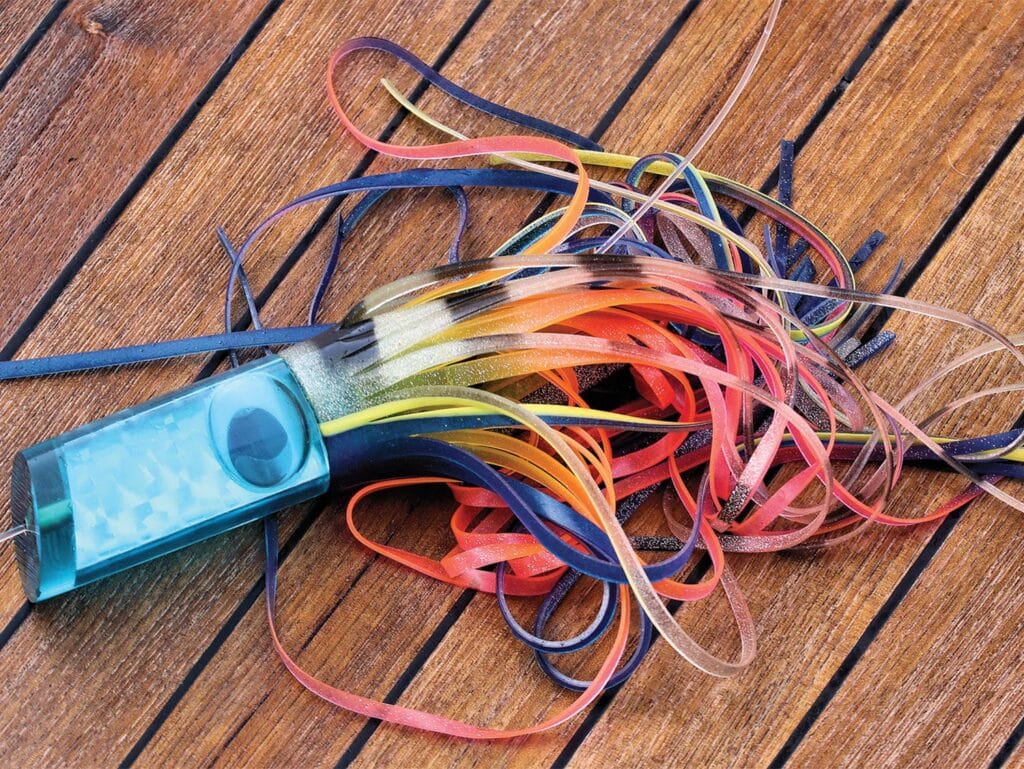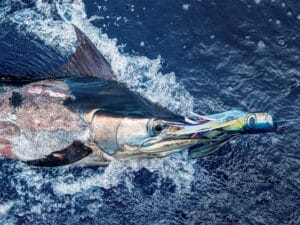
Special delivery: Sign up for the free Marlin email newsletter. Subscribe to Marlin magazine and get a year of highly collectible, keepsake editions – plus access to the digital edition and archives.
Whenever I see a photo of a big marlin online or read a story about a great day of fishing, I want to know what the fish was caught on. Did it fall to a lure, dead bait or live bait?
I am lucky enough to get to watch all the release videos in my tournaments that I run in the Bahamas each May, and while my main priority is certifying the catch for the tournament, I’m also always looking one layer deeper at the methods used to catch that fish.
Quite a few of the blue marlin caught in the tournament are small, and we also get plenty of white marlin, sailfish and a few spearfish, so it’s no surprise that many of the fish are caught on swimming circle-hook ballyhoo. Crews find it’s always worth pulling those ballyhoo on 20- and 30-pound tackle for the extra release points. These boats and anglers also have pitch baits ready to deploy to larger marlin that come up on the dredges and teasers. And then some boats pull only hooked lures, just looking for that big marlin.
This summer, after my tournaments were done, I enjoyed looking at the photos from the Hawaiian tournaments, with all of the boats and their 130-pound rods and reels in the cockpits. These guys love their lures and fish them with great success. When they post a photo or a video, I’m always interested in what lure it was that caught the big fish—not just the colors of the skirt, but the brand and style of the lure itself.
As mentioned in Capt. Chris Donato’s “Made in Hawaii” feature in the October issue, I was quoted many years ago saying that all lures are equal at eight and a half knots. Black Bart hated me for that quote. What I meant was that they are all basically cylinders going through the water with hooks in them. Yes, a jet is a completely different lure than a slant-cut plunger, but within each style, the names may change but the action does not. An old Chee lure or a brand-new Moyes J Boy will both catch you a prize marlin.
But I love the way that the crews in Hawaii really believe in their lures. Many captains, in fact, are steadfastly committed to a favorite lure manufacturer or two. In the month of July, Jody Bright and his Kona Marlin Tournament Series even host a Hawaii Lure Makers Challenge so the lure guys can face off and declare a winner. They do get plenty of bites to prove they know what they are doing.
Kona waters are usually quite calm, and with the lures they use, it is important to get them on the face of the wave to get them to ride correctly. Unfortunately, our waters on the East Coast of the US, and in the Bahamas and Caribbean, are usually rough. They require a different approach. I was lucky to fish lures with Jeff Fay and Doug Haigh in the early 1980s, and they taught me a lot about lure-fishing. In the waters over the North Drop, Doug would adjust the lures every five minutes depending on which direction the captain was turning the boat.
Lure-making principles do change over time, of course. Today’s skirts really make a difference. They are much longer, which we believe helps the hookup ratio. Today’s colors are more vibrant than we pulled years ago, and lures are easier to re-skirt than when we used the old lawn-chair material.
Read Next: The Craft and Tradition of Hawaii Lure Making.
Years ago, I never would have predicted how nuanced bait presentation would become thanks to the rise of omni. These days if you mark a marlin and don’t get a bite, it’s time to adjust your spread. This has certainly proved to be true with live baits. When the live-bait guys mark a marlin and send down a skipjack, if they don’t get a bite, they’ll change it out for a small yellowfin tuna to try to trigger some interest.
Is it time to apply that to our lures and teasers also? When we mark a fish that proves disinterested, is it time to swap out new lures or colors?
Maybe I’ll ask one of those skippers in Hawaii.







